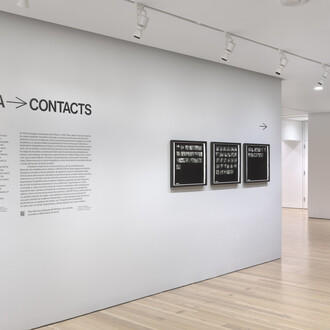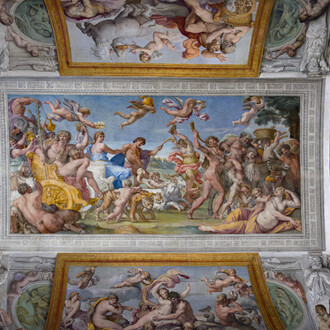Arte Continua is pleased to present, as of Saturday February 15, the group show FOREVER AGAIN AND AGAIN, which brings together a group of artists who have a common feature: the work of each of them is conceived around an obsession, a tireless search towards one direction. They are artists obsessed with an idea, a concern. Many others can be derived from it, but the former will always lead the way.
Art history is filled with obsessed artists. For centuries their common practice was to insist on certain themes, repeat exercises, the infinite desire to return to the same thing over and over again, whether by the canons of the time or by the necessity of finding technical and formal solutions. However, through contemporary art, an infinite universe of reflection and experimentation is now open. Thus, the idea of art as a spectacle that demands a continuous renewal paved its way thanks to a context that’s constantly craving new sensations and realities. Thereby, it is indeed less frequent than it used to be for an artist to pursue one sole idea.
The exhibition in the former cinema Águila de Oro stages a dialogue between the obsessions of four Cuban artists and four international artists. On the one hand, the Cuban artists: Yoan Capote (Pinar del Río, 1977), Raúl Cordero (Havana, 1971), Michel Pérez Pollo (Manzanillo, 1981) and Ángel R. Ricardo Ríos (Holguín, 1965), and on the other hand: Daniel Buren (Paris, 1938), Arcangelo Sassolino (Vicenza, 1967), Serse (San Polo di Piave, 1952) and José Antonio Suárez Londoño (Medellín, 1955).
An artist who illustrates this idea par excellence is Daniel Buren. This time, the visual record based on colored lines that distinguishes his work transforms the gallery's facade, drawing attention towards the building itself and particularly its entrance.
In the field of painting we present Michel Pérez Pollo’s recurring ideas and his tireless search for metaphysical forms. Regardless of whether he derives a figure from plasticine molds, a fruit or the closure of a perfume bottle, these images prompt a sense of estrangement in the timeless atmosphere in which they are wrapped. Meanwhile, Raúl Cordero delves into the visual result of an image that tests the attention span in art and life. The work It is just a matter of priorities, one of his large-scale blurry paintings, places us before a room rarefied by its red atmosphere and the text that is superimposed above it with metallic pigments. Conversely to this sort of rational painting, the work of Ángel R. Ricardo Ríos stands out as one that is dominated by gesture and the artist’s infinite desire to represent nature as the apex of sensuality and eroticism. Moreover, the reason behind Yoan Capote’s renowned hook-paintings is the Cuban island’s condition and the issues that it carries. In his extensive Islands series, he presents us with seascapes that become tragic and sharp as we approach them and discover their tangible surface, covered in thousands of hooks they refer to the drama of migrating and the losses and separations that it causes through generations.
Furthermore, Serse focused throughout his career mainly in one medium: drawing. He has produced over the years some extraordinary series that explore the sublime experience of landscape. Through his water vortexes he points towards a specific scale of representation, as well as the idea of constant fluidity. Meanwhile, José Antonio Suárez Londoño created a kind of diary that thoroughly describes his context and concerns. It is difficult to determine if each of these drawings and engravings is an independent work or, rather, they are part of a general body of work in constant progress. Indeed, he focuses on recording, in an almost obsessive way, a certain inventory of the world which moves through a diversity of images that are encapsulated in small format drawings and etchings as if they were daily notes.
With his sculptures and installations, Arcangelo Sassolino attempts to explore mechanical behaviors, materials and physical properties of force, which serve him to reflect on the properties of nature. Hence, the tension that is generated when contemplating the height of these glass plates that are held together by a small press.
Three artists whose works are exhibited as long-term projects within the gallery space and are closely related to the theme of this exhibition, ultimately became part of it. Anish Kapoor’s (Mumbai, 1954) work When I am pregnant, presented at the center of the stage, tests the act of contemplation; accompanied by his video Wounds and Absent Objects. Of Kader Attia (Seine-Saint-Denis, 1970), one still finds the traces of his intervention on the floor of the stage. This sort of "reparation" was born from his endless desire to explore the broad repercussions of cultural hegemony and colonialism in dissimilar contexts. Finally, by Jorge Macchi (Buenos Aires, 1963), the work Before and After is displayed: a wall of suspended bricks that diverts the gallery’s entrance and presents one of the artist’s fundamental concerns: his interest in addressing in a symbolic and poetic way the notions of space and time.
From divergent inquiries, each of these artists stands as a world in itself. For them art cannot solve problems; an answer will only lead to a new question. Therefore, it is essential to return to them forever, again and again.












